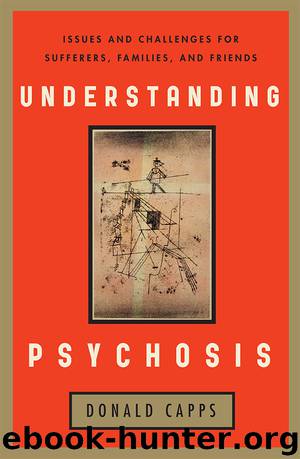Understanding Psychosis by Capps Donald

Author:Capps, Donald [Capps, Donald]
Language: eng, fra
Format: epub
Publisher: Rowman & Littlefield Publishers
Published: 2014-01-09T16:00:00+00:00
Chapter Six
The Emergence of Psychotic Illness: The Role of Acute Identity Confusion
In the introduction, I note the observation of the Diagnostic and Statistical Manual of Mental Disorders (DSM-IV-TR) that the differential diagnosis between dissociative identity disorder and the psychotic disorders is complicated by their apparently overlapping symptom presentations. For example, the presence of more than one dissociated personality state may be mistaken for a delusion, or the communication from one identity to another may be mistaken for an auditory hallucination, leading to confusion with the psychotic disorders. Also, shifts between states of identity may be confused with cyclical mood fluctuations leading to confusion with bipolar disorder.1
The fact that the potential for confusion in this regard exists indicates that persons who are experiencing severe identity issues or problems are likely to be at risk of developing a psychotic disorder or a disorder with psychotic features (e.g., bipolar disorder and dementia). As the DSM-IV-TR points out, dissociative identity disorder reflects a failure to integrate various aspects of identity and that each personality state may be experienced as if it has a distinct personal history, self-image, and identity, including a separate name. There is usually a primary identity that carries the individual’s given name and is passive, dependent, guilty, and depressed, and the alternate identities frequently have different names and characteristics that contrast with the primary identity (e.g., are hostile, controlling, and self-destructive). Also, particular identities may emerge in specific circumstances and may differ in reported age and gender, vocabulary, general knowledge, or predominant affect. Alternate identities are experienced as taking control in sequence, one at the expense of the other, and may deny knowledge of one another, be critical of one another, or appear to be in open conflict.2
Although the primary diagnostic criterion for dissociative identity disorder is the presence of two or more distinct identities or personality states, the manual indicates that most persons with this disorder have considerably more than two distinct identities. Women tend to have more identities than males, averaging fifteen or more, whereas males average approximately eight identities. It has a fluctuating clinical course that tends to be both chronic and recurrent. The average time period from first symptom presentation to diagnosis is six or seven years. The disorder may become less manifest as individuals age beyond their late forties, which indicates that it is most likely to be found among younger adults.3
Psychiatrists’ interest in this disorder dates back to the early 1800s. William James’s 1896 Lowell Lectures included a lecture on multiple personalities (the traditional term replaced by identity dissociative disorder), in which he related several examples of the disorder.4 He told about a woman, Mary Reynolds, who lived in Pennsylvania in the early 1800s. One day she awakened from a twenty-hour sleep in an unnatural state of consciousness. She had no memory and could barely speak and did not recognize her family or friends or her surroundings. Her personality was dramatically changed. Originally melancholy and taciturn, she became cheerful and buoyant, even a trickster, and she was much more socially active, although she acted as if she were among strangers.
Download
This site does not store any files on its server. We only index and link to content provided by other sites. Please contact the content providers to delete copyright contents if any and email us, we'll remove relevant links or contents immediately.
Rewire Your Anxious Brain by Catherine M. Pittman(17587)
Talking to Strangers by Malcolm Gladwell(11875)
The Art of Thinking Clearly by Rolf Dobelli(8841)
Mindhunter: Inside the FBI's Elite Serial Crime Unit by John E. Douglas & Mark Olshaker(7833)
Becoming Supernatural by Dr. Joe Dispenza(7103)
Change Your Questions, Change Your Life by Marilee Adams(6639)
Nudge - Improving Decisions about Health, Wealth, and Happiness by Thaler Sunstein(6633)
The Road Less Traveled by M. Scott Peck(6633)
The Lost Art of Listening by Michael P. Nichols(6469)
Enlightenment Now: The Case for Reason, Science, Humanism, and Progress by Steven Pinker(6405)
Win Bigly by Scott Adams(6310)
Mastermind: How to Think Like Sherlock Holmes by Maria Konnikova(6234)
The Way of Zen by Alan W. Watts(5798)
Daring Greatly by Brene Brown(5639)
Grit by Angela Duckworth(4735)
Big Magic: Creative Living Beyond Fear by Elizabeth Gilbert(4723)
Men In Love by Nancy Friday(4319)
Flow by Mihaly Csikszentmihalyi(4051)
The Four Tendencies by Gretchen Rubin(4024)
